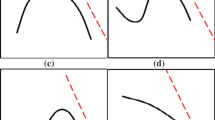Conclusions
-
1.
On the basis of the work performed, a generalizing relation for determing the optimal density of clay-rubble soils with various contents of fines and its various physical and mechanical characteristics is proposed.
-
2.
A relation is proposed for determining the minimum allowable content of fines in clay-rubble soil used for watertight components of dams.
-
3.
A relation and method are proposed which makes it possible to check and control the technological process when enriching clay-rubble soils with fines when placing them in watertight components of dams.
The proposed method of assigning the optimal density of clay-rubble soils will make it possible to refine more promptly the optimal density of soil in relation to the technology of performing the work and compacting mechanisms and thereby to reduce the volume of field experiments.
Similar content being viewed by others
Literature cited
V. V. Burenkova, “Seepage properties of clay soils with coarse-grained inclusions,” in: Paper Presented at the Third Conference of Young Researchers on Problems of Hydraulic, Engineering and Reclamation Devoted to the 100th Anniversary of the Birth of V. I. Lenin [in Russian], UkrNIIGiM, Kiev (1970).
V. S. Istomina and V. V. Burenkova, “Investigations of the seepage stability of clay soils with coarse-grained inclusions,” in: Collection of Papers of the Second Scientific-Technological Conference [in Russian], Gidroproekt, Moscow (1972).
E. N. Batenchuk, P. V. Biyanov, L. N. Toropov, and Yu. N. Myznikov, Winter Placement of Cohesive Soils in the Far North [in Russian], Énergiya, Moscow (1968).
M. P. Pavchich, “Basic principles of the design and selection of soil mixtures,” Izv. VNIIG, No. 108 (1975).
M. P. Pavchich and O. A. Pakhomov, “Experimental substantiation of maximally dense soil mixtures,” Izv. VNIIG, No. 111, 3–10 (1976).
A. N. Ermolaeva, B. F. Rel'tov, M. P. Pavchich, et al., “Artificial mixture of loam with gravel-sand soil as a material for constructing a dam core,” Izv. VNIIG, No. 111, 11–16 (1976).
S. V. Bortkevich, “Main requirements imposed on the quality of skeletal clay cores of earth-rock dams,” Gidrotekh. Stroit., No. 8 (1973).
S. V. Bortkevich, V. I. Vutsel', A. G. Chernilov, and N. F. Roiko, “Quality control of the compaction of earth materials in the construction of high dams,” Gidrotekh. Stroit., No. 5 (1981).
L. N. Rasskazov, Yu. P. Pravdivets, and Yu. N. Myznikov, “Preparation of soil for placement in watertight components of dams in the Far North,” Énerg. Stroit., No. 2 (1980).
Manual on Quality Control of Earth Dam Construction: II 42-75 [in Russian], VNIIG, Leningrad (1976).
Wasser- und Energiewirtschaft cours d'eau et energie; Sanderheft Barrager en Suisse rum 7. Internationalen Kongres fur Groβe Talsperren in Rom (1961), pp. 261–265.
M. M. Grishin, S. M. Slissky, L. N. Rasskazov, et al., Hydraulic Structures [Russian translation], Vol. 1, Mir, Moscow (1983).
Additional information
Translated from Gidrotekhnicheskoe Stroitel'stvo, No. 7, pp. 17–21, July, 1987.
Rights and permissions
About this article
Cite this article
Burenkova, V.V. Assignment of the characteristics of clay-rubble soils in watertight components of earth dams. Hydrotechnical Construction 21, 401–407 (1987). https://doi.org/10.1007/BF01427268
Issue Date:
DOI: https://doi.org/10.1007/BF01427268




